
Social Psychologist & Personal Advisor
Vital and Census Records Can
Enrich Family History
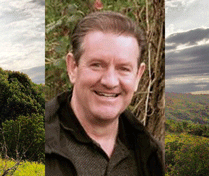

Counseling Approach: Adapting Language to Each Client
Teaching People How To Do Family History Research Online
Determined and Dependable: Dr Matt's Family Heritage
Premise for Family History Therapy: Why It Works
Who was Marilyn Monroe's Biological Father?
Excerpts from Changing Your Stripes
Tell-Tale Signs of Betrayal
How Great is Number Eight?!
by Matt Moody, Ph.D.
My 8th Great Grandfather, Jacob Barney Jr., was born 1628 in Bradenham, Buckinghamshire, England -- a town where two generations of Barneys were born before -- his father, Jacob Barney Sr. (1601), as well as his grandfather, Edward Barney (1575).
According to the "Barney Family Historical Association," in 1634 Jacob Barney Sr. and his wife, Elizabeth Catesby, took their family of 3 children, ages 1, 3, and 6, and boarded a ship bound for America. They left England for one compelling reason: to escape religious persecution! In what is known as the "eleven years of tyranny," King Charles directed his Archbishop to purge Puritans from the Church of England. By moving to Salem, Massachusetts, the Barney family found the freedom to live their Puritan faith.
Jacob Jr. was 6 years old when he crossed the Atlantic Ocean with his parents and siblings. When he matured to a marriageable age, Jacob married two American-born women (one at a time): first Hannah Johnson in 1657, and then he married my 8th Great Grandmother, Ann Witt in 1660. Note below how my ancestral line goes through 3 generations of great grandfathers with the same name: "Joseph Barney."

After coming to America, when Jacob Jr. was old enough to make his own adult decisions, he chose to leave the Puritan faith and join the Baptist Church. In response to this decision, Jacob Sr. disinherited his son. This is a curious irony, because Jacob Barney Sr. left England to enjoy "freedom of religion" in America, but when his son also wanted to exercise his "freedom of religion," Jacob, Jr. was cut out of his inheritance! In the mind of Jacob Barney Sr., freedom of religion means remaining a Puritan -- and becoming a Baptist was out of bounds.
According to "The Genealogy of the Barney Family in America," my 8th Great Grandfather eventually became a Reverend in the Baptist Church. Further, Jacob Barney Jr. was responsible for founding churches in Charlestown and Swansea, Massachusetts, and he was one of the founders of the First Baptist Church in Boston.
A Family History Story told solely through
Birth, Death, and Marriage Dates
While few other details are known about Jacob Barney Jr., an important story is told through the record of birth, death, and marriage dates. See what you can learn from perusing the following information:
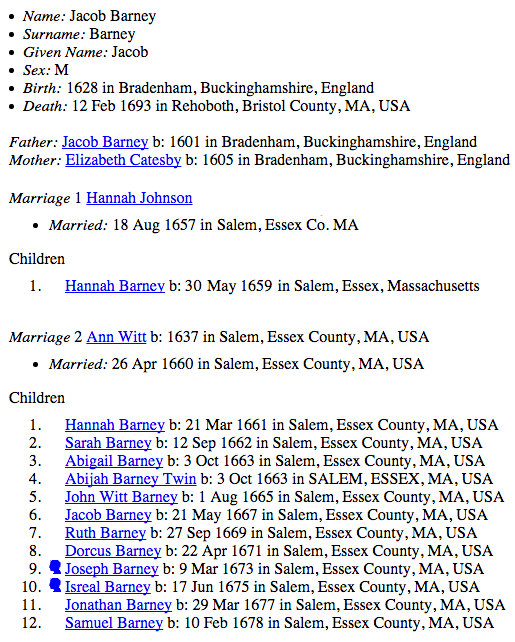
Why was the marriage to Hannah Johnson so short? The following years of death for Hannah Johnson and her new born baby, Hannah Barney, tell the sad tale:
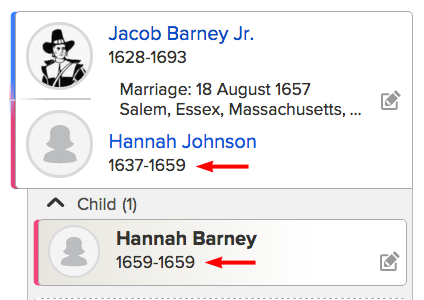
Jacob's first wife "Hannah Johnson" died 5 June 1659, six days after giving birth to her daughter, Hannah -- most likely her death was due to complications during child birth. Named after her mother, "Hannah Barney" also died in June of 1659. I am moved to tears when I think of the reality of this sad moment in time, a moment known solely through the record of birth and death dates.
In April 1660, eleven months after the passing of his wife and baby daughter, Jacob Barney married again; his second wife was my 8x Great Grandmother "Ann Witt." Ann gave birth to 12 children, and the first child was named "Hannah" (1661) after the baby daughter who died days after her birth and the mother who bore her.
Among their 12 children, I descend through the 9th child of Jacob and Ann Barney: Lieutenant Joseph Barney, born 1673. The 1st of three generations of "Joseph Barneys," my 7th Great Grandfather married Constance Davis on 4 September 1692 in Salem, Massachusetts -- when the Salem witch trials were in full swing.
Breathing Life into Family Stories
by Adding Historical Context
It was in March of 1692 that my 4th cousin (7x removed) Ann Putnam became a key accuser in the "witch trials" in Salem, Massachusetts. Born in 1679, Ann was just 13 years old at the time.
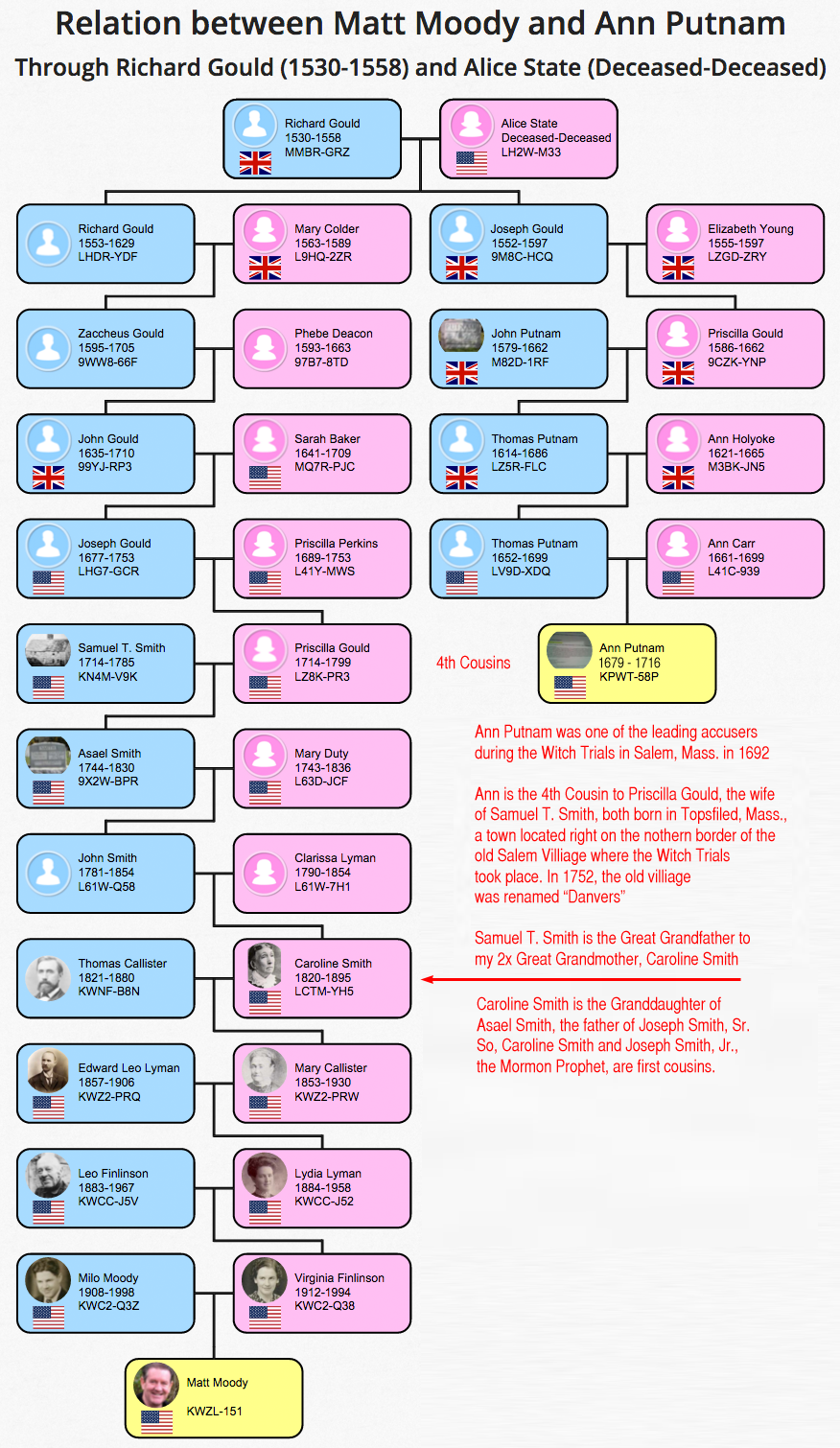
On her side of this Relationship Tree, note that Ann Putnam had a Great Grandmother named Priscilla Gould (1586), and she also had a 4th Cousin named Priscilla Gould (1714) on my side of this Relationship Tree.
Ann Putnam specifically accused Martha Corey and her husband Giles Corey of witchcraft. In September 1692, the very month that my 7x Great Grandfather Joseph Barney was married, Martha Corey was executed by hanging in the village of Salem Massachusetts; her husband, Giles Corey, died while being coerced to enter a plea to witchcraft charges. The forceful coercion that eventually caused his death is called "peine forte et dure" or pressing. This type of torture was administered by the town Sheriff.
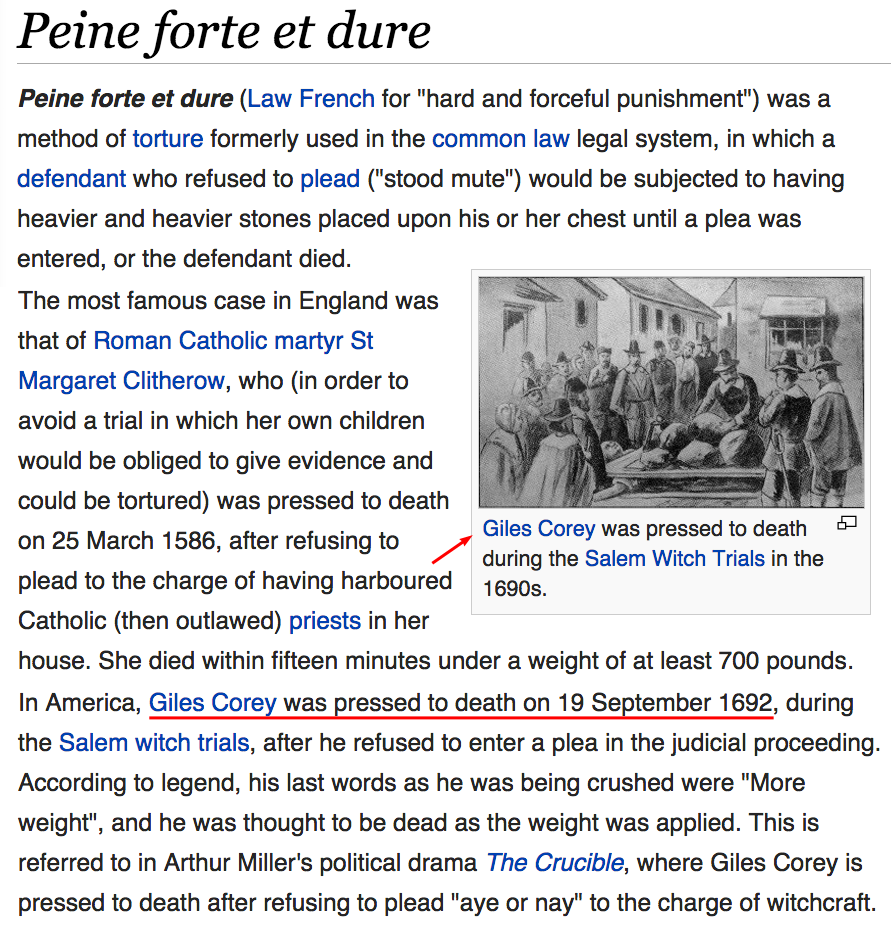
Again, Ann Putnam was one of the leading accusers during the Salem Witch Trials of the 1690s. Fourteen years after the trials were over, and many innocent people were executed by hanging, in 1706 Ann Putnam apologized for accusing Giles and Martha Corey (among others) of witchcraft -- an accusation that led to their deaths. Here is Ann's public apology for her role in the Salem Witch Trials:
"I desire to be humbled before God for that sad and humbling providence that befell my father's family in the year sixteen ninety-two; that I, then being in my childhood [age 13], should, by such a providence of God, be made an instrument for the accusing of several people for grievous crimes, whereby their lives was taken away from them."
"Now I have just grounds and good reason to believe they were innocent persons; and that it was a great delusion of Satan that deceived me in that sad time, whereby I justly fear I have been instrumental, with others, though ignorantly and unwittingly, to bring upon myself and this land the guilt of innocent blood; though, what was said or done by me against any person, I can truly and uprightly say, before God and man, I did it not out of any anger, malice, or ill will to any person, for I had no such thing against one of them; but what I did was ignorantly, being deluded by Satan."
"I desire to lie in the dust, and to be humble for it, in that I was a cause, with others, of so sad a calamity to them and their families; for which cause I earnestly beg forgiveness of God, and from all those unto whom I have given just cause of sorrow and offense, whose relations were taken away or accused."
~ Ann Putnam, 1706, age 27
On 3 October 1692 the President of Harvard College, Increase Mather, denounced the use of "spectral evidence" in the Salem Witch Trials. Spectral evidence was the testimony of a witness who claimed to have seen or heard a ghost. Due to Increase Mather's strong denunciation, spectral evidence was abolished.
Increase Mather is the father of Reverend Cotton Mather, who was the church authority who confronted the very first person accused of witchcraft -- Goody Glover. Cotton Mather encouraged her to repent. In 1688, Goody was also the very first "witch" to be executed by hanging.
Both Increase Mather and his son Cotton Mather are found in my Family Tree as follows:
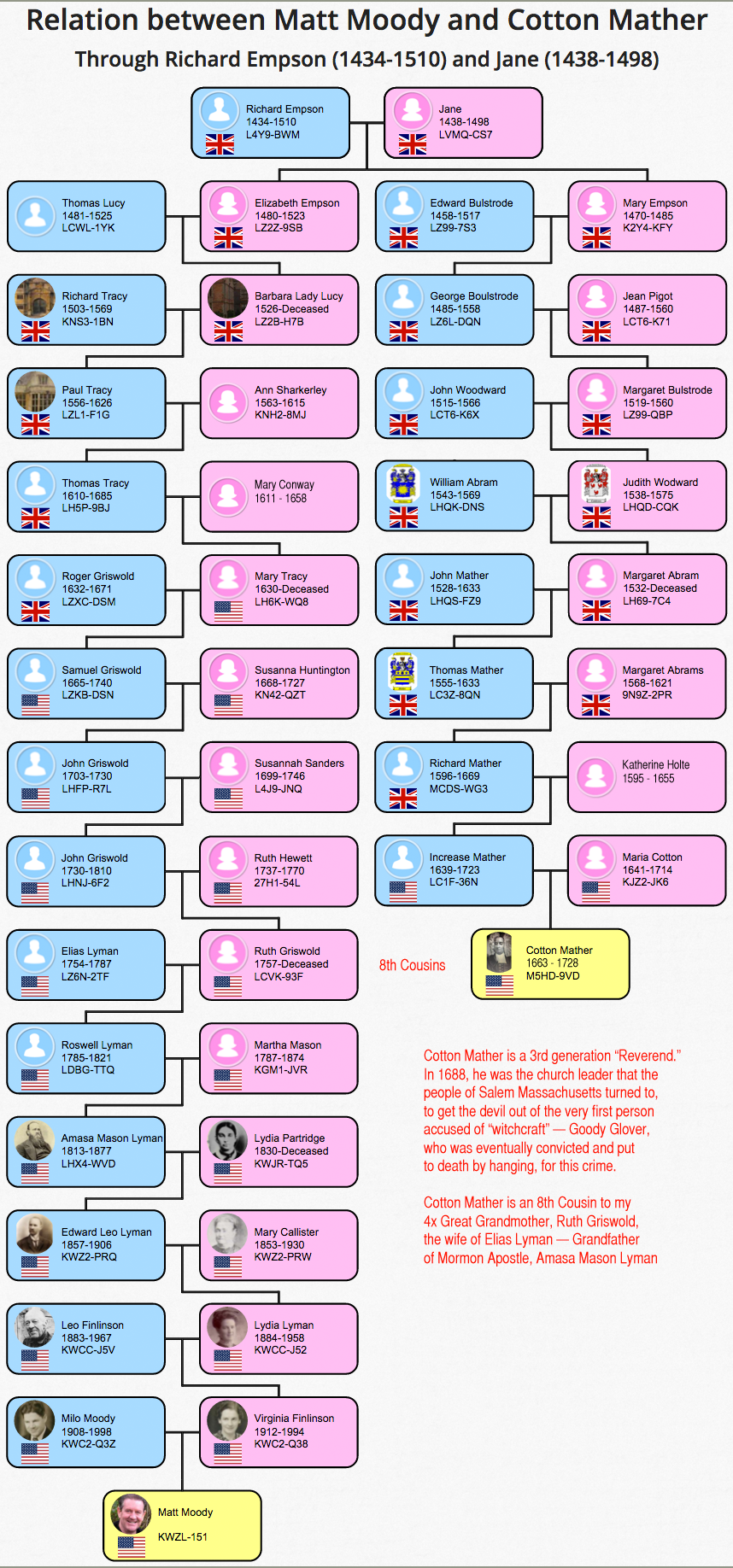
Here's a brief summary of the witch trial chronology and events.
* * * * * * *
Using Vital and Census Records To
Enrich Family History Stories
by Matt Moody, Ph.D.
This is my Great Grandmother Cynthia Elizabeth Damron (left), and her older sister Sarah Matilda Damron:
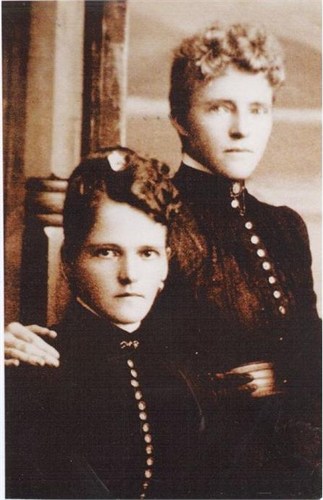
At the age 13, my great grandmother Cynthia Elizabeth Damron (1837) was living with her parents and siblings on a ranch in Ellis County Texas, 30 miles south of Dallas, Texas. You can see that the census (below) was administered under the authority of "Henderson" county -- the county immediately east of Ellis County.
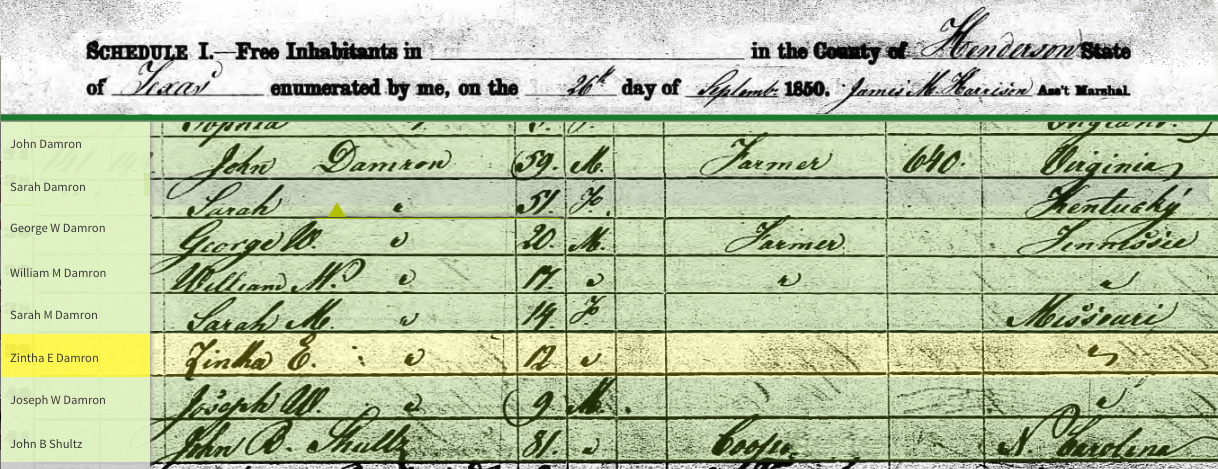
Although the census-taker wrote down "12" years old, Cinthy was actually "13," because she had already celebrated her August 9th birthday before the census was taken on 26 September 1850. Whoever represented to the census-taker the ages of each member of the family forgot that Cynthia just had her birthday in the previous month. Such inaccuracies are fairly common in U.S. census data -- and it's not always the fault of census-takers.
While some census-takers don't consistently record information accurately, it's also true that census respondents don't always offer accurate information in the first place. That's one reason why, in terms of reliability, the information in vital records (birth, death, and marriage records) should "trump" data from census records.
Further, legibility is sometimes a problem when relying upon census data. In the 1850 census (above), because we know the names and ages we are looking for, we can manage to decipher them. And because they didn't know the correct answers from the start, the Indexers of this 1850 census transcribed two errors: The age of Sarah M. was indexed as "19," when we know she was actually "14," and John Damron's wife, Sarah Shultz Damron had her father living in the home -- and his age was incorrectly indexed as "31" instead of "81."
In the same year of 1850, Cynthia's future husband was living in Utah, with his wife, Harriett Parthena Henson. In 1850 William C. Moody was father to four of seven children.
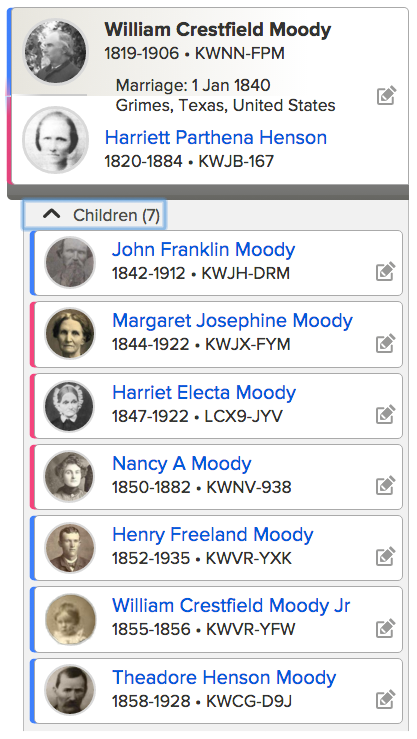
In 1855 William C. Moody was called to serve a mission in Texas. I've not yet discovered the specific date of William's mission departure, but I'm assuming that the optimum time to travel long distances in 1855 was at the first of the summer, after the rainy season of spring and before the cold weather of winter. Based upon this "window of opportunity," it's most likely that William left some time after 2 May 1855, which is the birthdate of his name sake, William Crestfield Moody Jr. -- a son who lived only 18 months and died while William was on his mission. Life was not easy for these pioneers.
At age 18, my great grandmother Cynthia Elizabeth Damron (1837), was contacted by Mormon missionaries while living with her family on a ranch 30 miles south of Dallas, Texas. The Damron family learned of the restored gospel through the preaching of William Cresfield Moody (1819) and his companion, younger brother John Monroe Moody (1822).
Cynthia Elizabeth accepted the message preached by the two Moody brothers and became a baptized member of The Church of Jesus Christ of Latter-day Saints, 4 March 1856. Cynthia's older siblings Sarah Matilda (1836), William Wallace (1833), George Washington (1830), as well as a younger brother, Joseph Warren Damron (1841) were also baptized into the LDS Church.
Cynthia's mother Sarah Shultz Damron (1799) joined the Church at this time, but her father did not. And just weeks after members of the Damron Family were baptized, John Damron (1791) died April 1856 -- leaving Sarah and the children to do the work of running a "fairly prosperous ranch" in Ellis County Texas -- a ranch that they would eventually abandon as the Damron Family moved west to Utah. Because their Ellis County property was first acquired through "homestead" agreements, the Damron family could not simply sell the property but had to remain in residence to retain ownership rights. So the Damron family left their home and their land in Texas.
A main motivation for leaving Texas was to escape "Prejudice and hatred against Mormons" (Moody Book, p. 387). So a year after joining the Church, Cynthia Elizabeth and her sister Sarah Matilda decided that to Utah to be with the latter-day saints in Utah.
It was in the spring of 1857 that Cynthia and Matilda, ages 19 and 21, with a friend Mary Louisa Whitemore (1838) age 19, rode horses from Ellis County Texas to Salt Lake City Utah -- a trek of 1275 miles. Part of the Homer Duncan Company, the three girls "passed and repassed Johnston's Army" along the way. The soldiers were excited to see three pretty young girls on the trail.
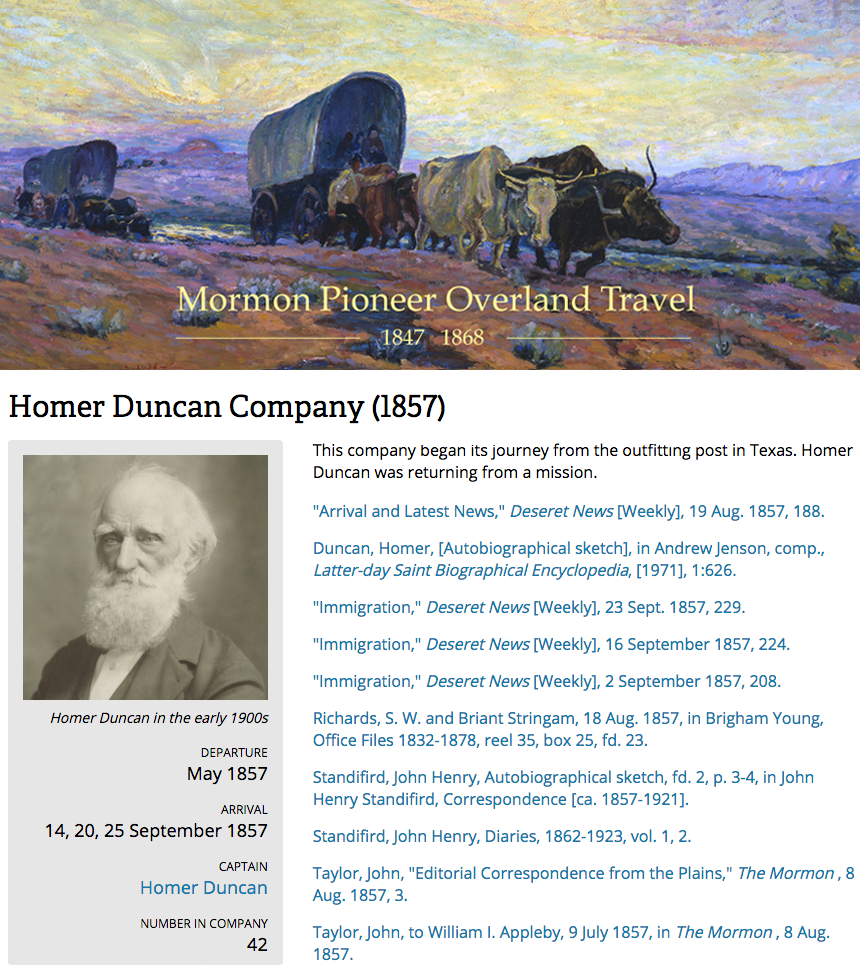
Just 3 months after arriving in Salt Lake Valley, the two Moody brothers, who preached the gospel to the Damron Family in Texas, would marry the Damron sisters on the same day: 20 December 1857 in the Endowment House at Salt Lake City. Cynthia Elizabeth and Sarah Matilda became the 3rd wives of the Moody brothers, William Cresfield and John Monroe Moody. The Moody brothers were both married men when they served their first mission in Texas. In the Territory of Utah in 1857 there was no law prohibiting plural marriage.
Also at Christmas time 20 December 1857, William C. Moody married Lola Eliza Bess just prior to marrying Cynthia Elizabeth Damron -- both Lola, the 2nd wife, and Cynthy, the 3rd wife, were 20 years old. Lola and Cynthy gave birth to their first their first babies. Lola gave brith to "Laura Moody" and Cynthy gave birth to "George Damron Moody."


Soon after the birth of George Damron, William Cresfield, with his new wives Lola Bess (1837) and Cynthia Damron (1837), move from Salt Lake City to Fort Ephraim in Sanpete County, Utah. Because the "Utah War" was resolved in April 1858, it appears that the Moody family did not leave Salt Lake City due to the threatening presence of 2,500 Federal Soldiers in Johnston's Army -- some who had threatened to "kill some Mormons." Fort Ephraim is the same as the Utah town "Ephraim," located 120 miles south of Salt Lake City.
According to the U.S. Department of Transportation, In 1860 "covered wagon made 8 to 20 miles per day depending upon weather, roadway conditions and the health of the travelers." So the trip from Salt Lake to Ephraim took from 7 to 14 days to complete: with first-time mothers Lola and Cynthy each carrying a new-born child. In 2015, it takes 2 hours to drive by car from Salt Lake to Ephraim. Curiously many people loathe the idea of taking a Bus the same distance: a 3-1/2 hour journey. Compare a slow bus, to a slow covered wagon? Now the dreaded Bus Ride doesn't sound so bad in comparison.
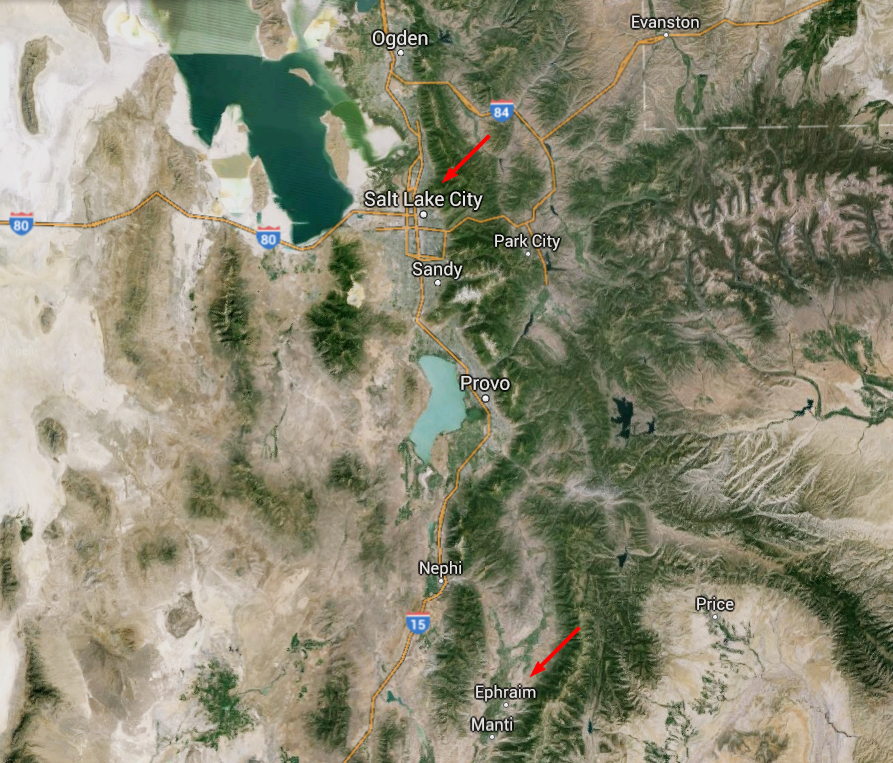
The 1860 U.S. census (below) establishes that Lola Eliza was caring for her first born child "Laura," age 1, and Cynthia Elizabeth was nursing her first born child "George," who was 4 months old at the time of the census. Fort Ephraim was where Lola and Cynthia would live for the next two years while their husband served his second mission for the LDS Church in England.
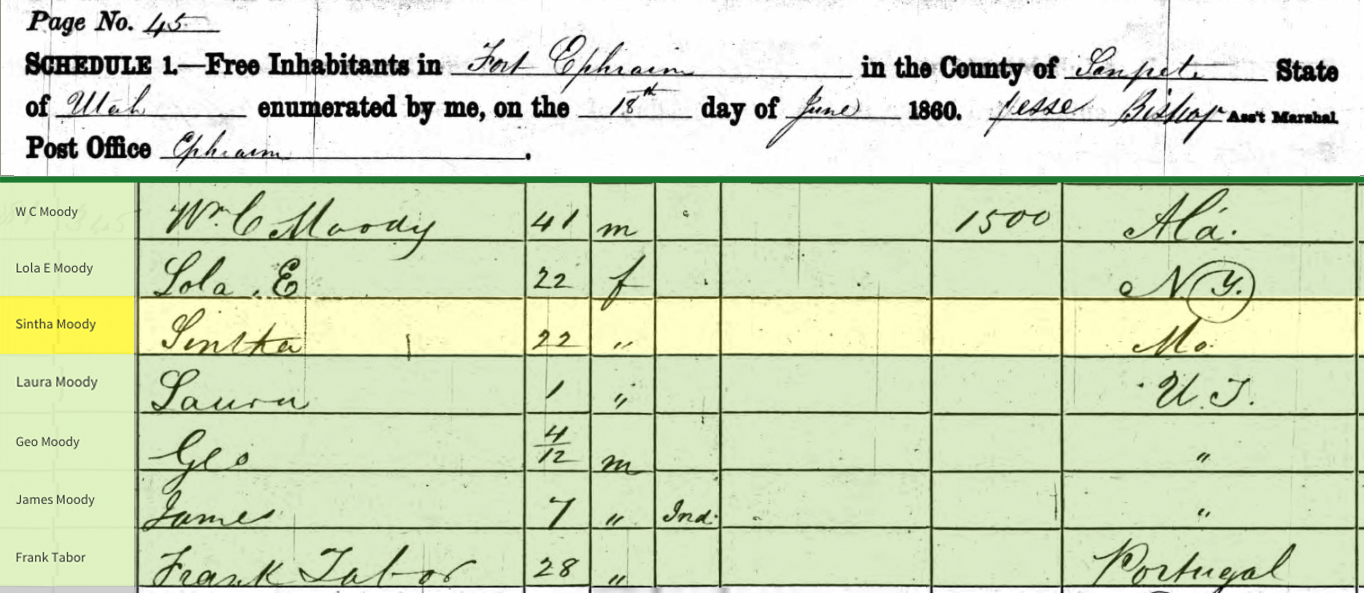
Also living with the Moody Family at Fort Ephraim is "Frank Tabor" from Portugal. Frank was the hired hand who would help Lola and Cynthia and their new-born babies survive for the next two years.
The 1860 census in Sanpete county also shows that a 7-year-old "Indian" boy named James Moody was living with the family. Before leaving on his second mission, one day William Cresfield observed an Indian father beating his son. To spare the boy from further abuse, William C. offered the abusive father a horse, in trade for the boy. Amazingly, the Indian father took the deal -- I personally completed the proxy temple work for "James Moody" in the Provo Temple in June of 2014.
In the Big Blue Moody book, "John Wyatt Moody Family Past and Present," this Indian boy is called John, but the U.S. census record has his name as "James." Also in the Moody book, it refers to Cynthia Elizabeth Damron as "Betty," but 1850 and 1860 U.S. census records show the name reported to the census-taker was "Cintha" -- which is most likely the name she was commonly called, and most importantly the name she preferred to go by. Clearly, she could have told the census-taker the name of "Betty," but she didn't.
Shortly after William Cresfield returned from his mission in England, the Church then called the Moody Family to settle in St. George. Here is the family's reaction to that call when is was first received:
"One day when William had been home only a few months, he was asked to attend a special meeting. When he returned, everyone could sense that he was troubled and he was very pale. He revealed his call to Dixie as a colonizer. The family was dismayed at the sacrifices they would have to make, but they obeyed the call to leave their pleasant valley for the deserts of Utah's Dixie." (Big Blue Moody book, p.387).

This would be the 2nd of five relocations for the William C. Moody Family; each move meant leaving the security of a home and starting over again. The trip from Fort Ephraim to St. George was 220 miles. A horse-drawn covered wagon could complete this journey in 11 days to a month -- averaging between 8 to 20 miles a day, depending upon road conditions, weather, and the health of the passengers as well as the animals. Two children were born to Cynthia while in St. George. The birthdates of Cynthia's children help establish the timeline for her 5 relocations.


Cynthia endured much hardship through five relocations: just when she had become used to a nice brick home in St. George, they were called to move again, this time to Spring Valley Nevada: "They were hungry and often cold at the 6000 foot elevation. Always they were busy trying to survive in a relentless land" (Big Blue Moody book, p. 479). In Spring Valley, while waiting for a house to be built, Cynthia and her 3 children lived in a "dug-out" -- which is essentially a hole in the ground covered by a quickly built roof.

Spring Valley is located 3 mile west of the famous Las Vegas Strip -- directly west of Caesar's Palace and the MGM Grand. The journey from St. George to Spring Valley is 125 miles, which would take from 7 days to 2 weeks to complete by horse drawn covered wagon.
From Salt Lake City to Fort Ephraim -- 120 miles
Fort
Ephraim to St. George -- 220 miles
St. George to Spring Valley -- 125 miles
Spring Valley to Dry Valley -- 180 miles
Dry Valley to Eagle Valley -- 10 miles
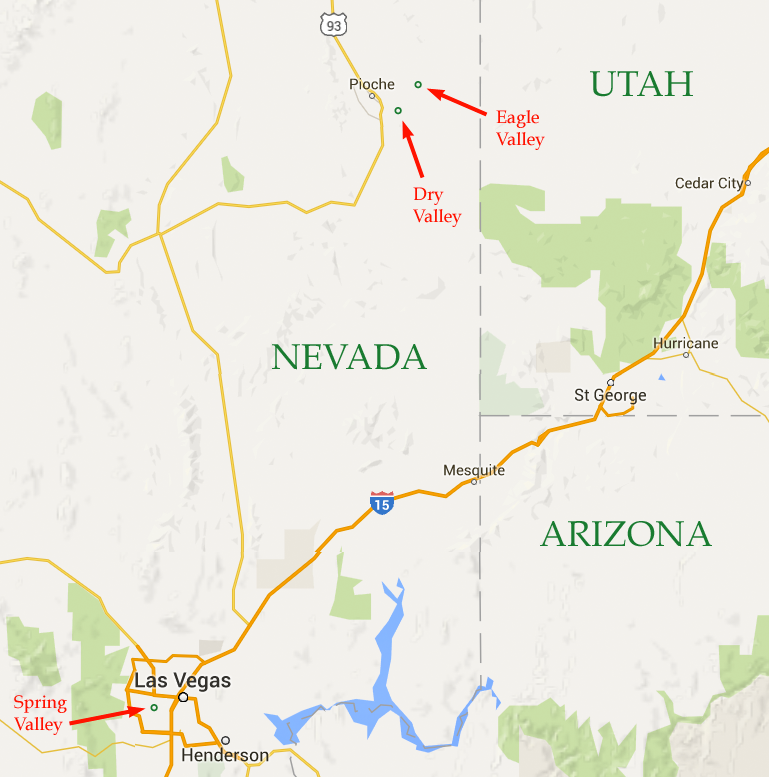
It was in Spring Valley, Nevada that my Grandfather, Milton Moody (1868) was born. At the age of just 18 months, while his mother Cinthy was busy cooking food in a Dutch oven, and after removing hot coals from the lid, she set the lid aside to get food from the oven. The young child, unaware that the lid was red hot, sat upon the lid, and had "St. Louis" branded on his bottom.

When Milton Moody was 4 years old, he suffered from a long illness. One night while lying awake, unable to sleep, Milton saw a personage with a bread dressed in white, who told him he would get well. And if he lived right, the Lord had a work for him, and he would be of much service in the Church. Young Milton told his parents about this experience the next morning.
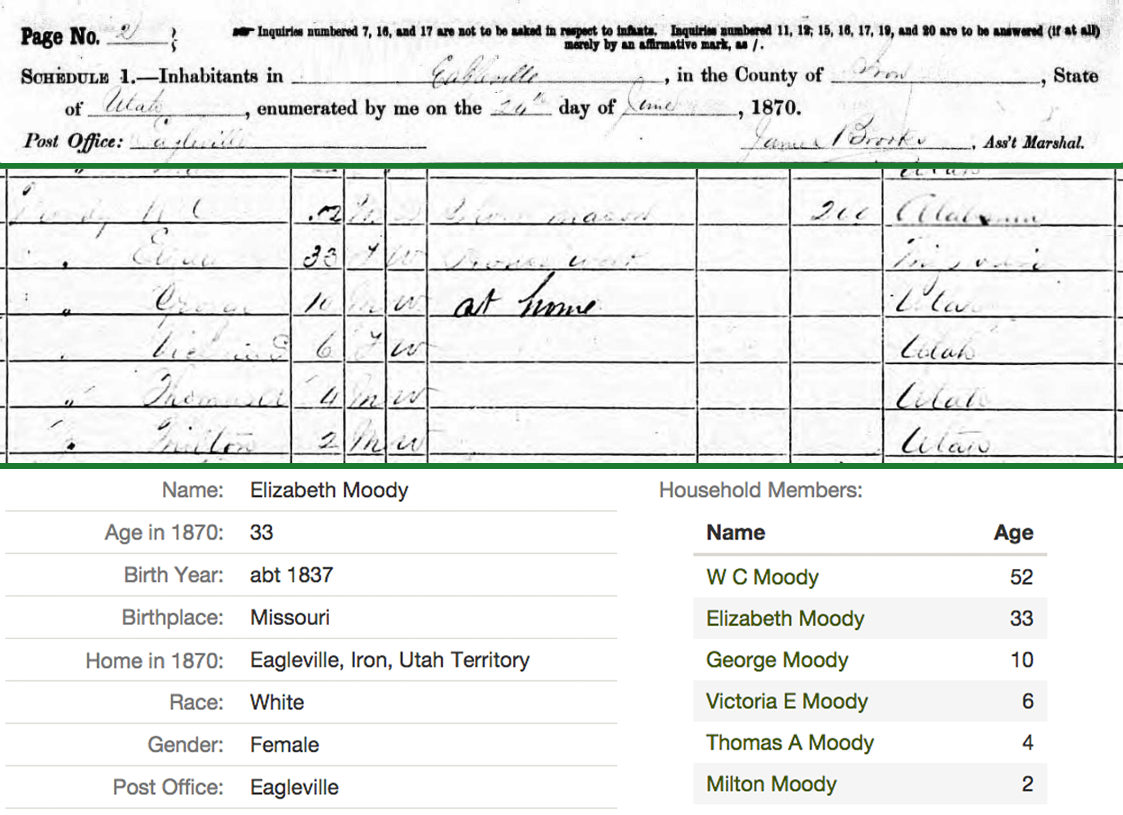
In the above census, Cynthy gives her name as "Elizabeth." This 1870 census was taken under the authority of "Eagleville" in Iron County of the Utah Territory. William C. Moody and Cynthy Elizabeth were residing in "Dry Valley" at the time. The following birth record for Cynthy's last child confirms the correct timeline:

William Alfred was born just 2 days after the 1870 census was taken. The birth place entered at FamilySearch.org shows "Dry Valley, Eureka, Nevada." In contrast, the 1870 U.S. census has "Dry Valley" as part of Iron County in the "State" of Utah. However, the census is wrong on two counts:
1) Utah did not become a "State" until 1896. At the time of the 1870 census, Utah was still a "Territory."
2)
Dry Valley became part of the State of Nevada in 1866.
Nevada became a State 35 years before Utah, because Nevada had silver mines, hence wealth that the U.S. Government wanted to tap into. I'm guessing that because the U.S. census forms were already printed, the 1870 census at Dry Valley proceeded under the authority of Iron County in the Utah Territory.
The move from Spring Valley to Dry Valley happened because William needed means to provide from his family. The following information at Rootsweb explains:
"The copper mines in Pioche, Nevada, were just opening up and they needed a bricklayer to build a mill in Dry Valley, which was eight or ten miles south of Eagle Valley. Betty's husband applied for and got the job. This was a cash contract and, as he said later, it probably kept his family from starving to death in that new, barren land. He felt that the Lord had blessed him in this matter because of his obedience to the calls that he had received from the Church. He made more money there than he had ever made before in his life."
"After receiving permission from the Church authorities, he moved his family to Dry Valley, and once again he built log cabins for his wives. These homes were all equipped with very fine fireplaces with tall brick chimneys."
Dry Valley is located 7 miles south-east of the silver mining town of Pioche, Nevada.
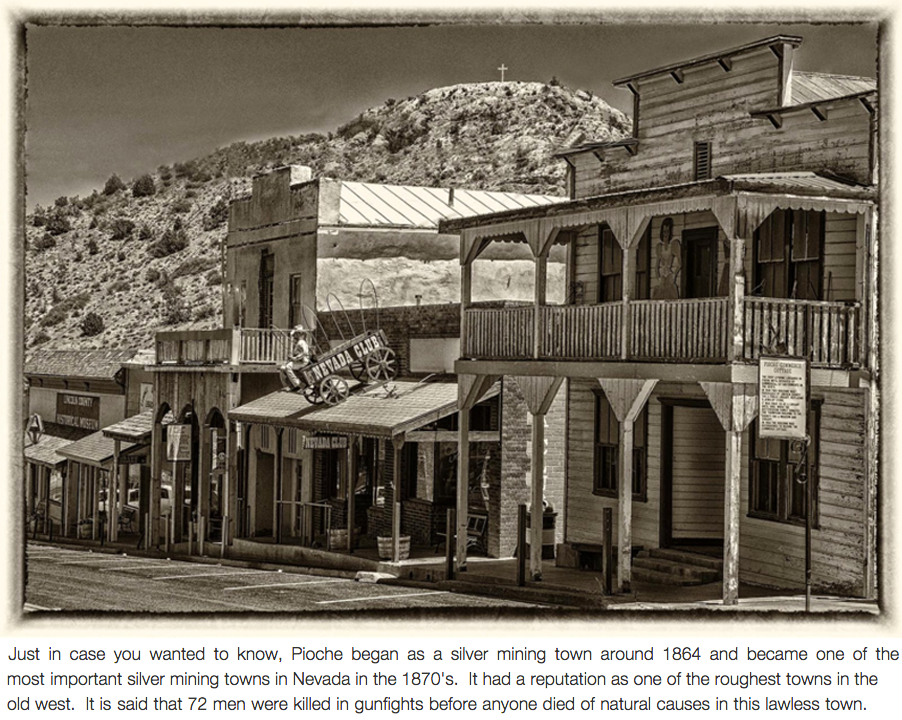
The final relocation that the Moody Family would make was from Dry Valley to Eagle Valley in Nevada -- just a 10 mile move, a journey made within 4 or 5 hours if everything went right.
My great grandmother Cynthia passed away in 1872 at the young age of 35. My grandfather, Milton Moody, was just 4 years old when his mother died. William Cresfield's 2nd wife, Lola Eliza Bess, began raising my grandfather, along with Milton's 4 siblings. Here's Cynthy's grave marker at Eagle Valley, Nevada.
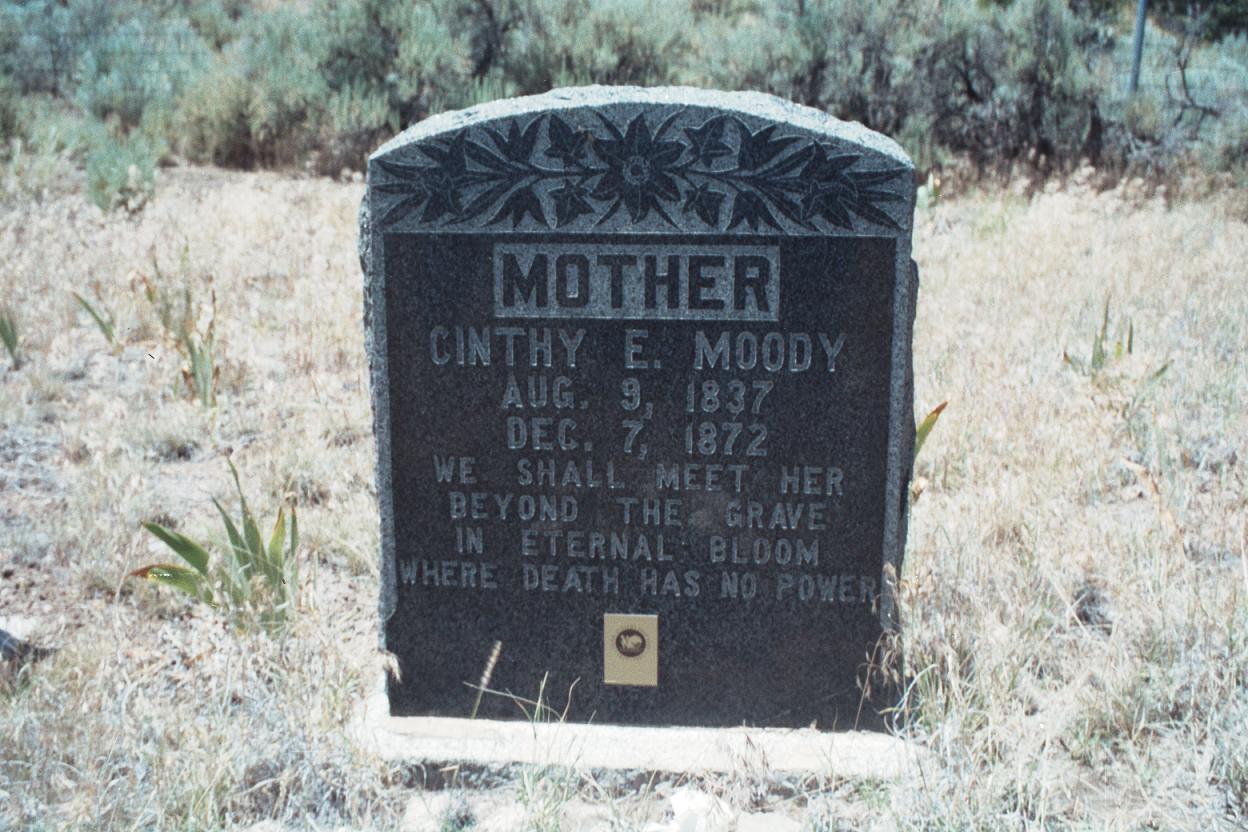
As confirmed by birth records, Lola's 4 youngest children were born in Eagle Valley. Lola Eliza Bess gave birth to a total of 11 children, and raised 5 of Cynthia's children from 1872.




Cynthia Elizabeth Damron and Lola Eliza Bess broke no laws by being sister wives to William Crestfield Moody. In 1874, two years after Cynthy's death, the U.S. Congress passed a federal law prohibiting the practice of polygamy.
After 1874 George Reynolds, the secretary to Brigham Young, was convicted of violating the federal law prohibiting plural marriage. Reynolds appealed his case to the U.S. Supreme Court, making the constitutional argument that "congress shall make no law prohibiting" the exercise of a person's First Amendment, Freedom of Religion rights. In 1879, the U.S. Supreme Court ruled against Reynolds, and upheld the lower court's ruling.
The 1880 U.S. Census has "Milton Moody" at 12 years of age, living with his 4 siblings, as well as 11 half-brothers and sisters that Lola Eliza Bess gave birth to.
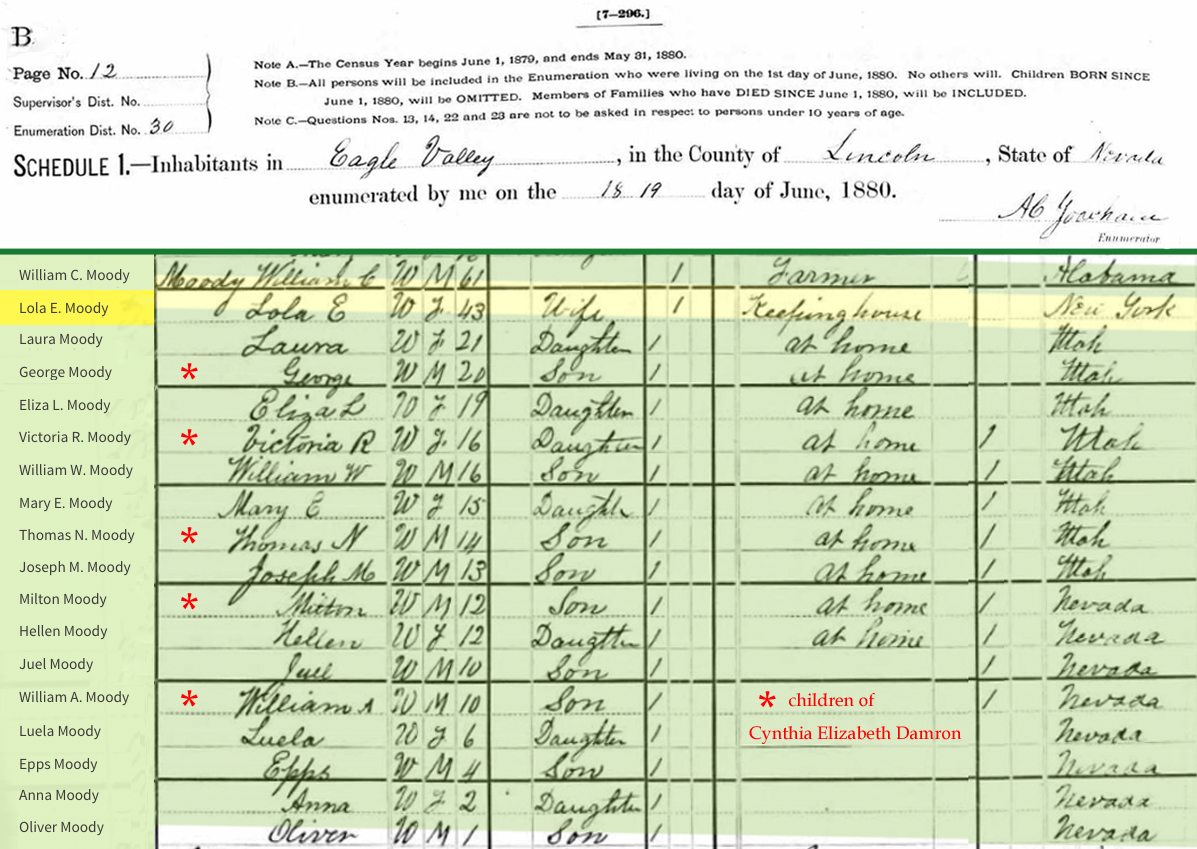
Above are 16 children living in the home of William Cresfield Moody and Lola Eliza Bess. Remember, Lola and Cynthia began their marriage to William Moody at Fort Ephraim, Utah, where Lola was caring for her first born, one year old Laura, and Cynthia was caring for her first born, four-month old George. Twenty years later, Laura and George are found in the 1880 census, at ages 21 and 20.
After William C. Moody married his 2nd and 3rd wives, his 1st wife, Harriett Parthena Henson, lived independently apart from her husband. The following list of children and birthdates indicates that just before giving birth to her last child, Theadore Henson Moody, Harriett moved 260 miles south from Salt Lake City to Summit, Utah. Harriett became pregnant with her last child immediately upon the return of her husband from his 2 year mission in Texas. She decided to relocate, to make room in her Salt Lake home for William's two new wives. In 2010 Summit Utah only had a population of 180 people, so in 1858, Summit Utah was an very small settlement.
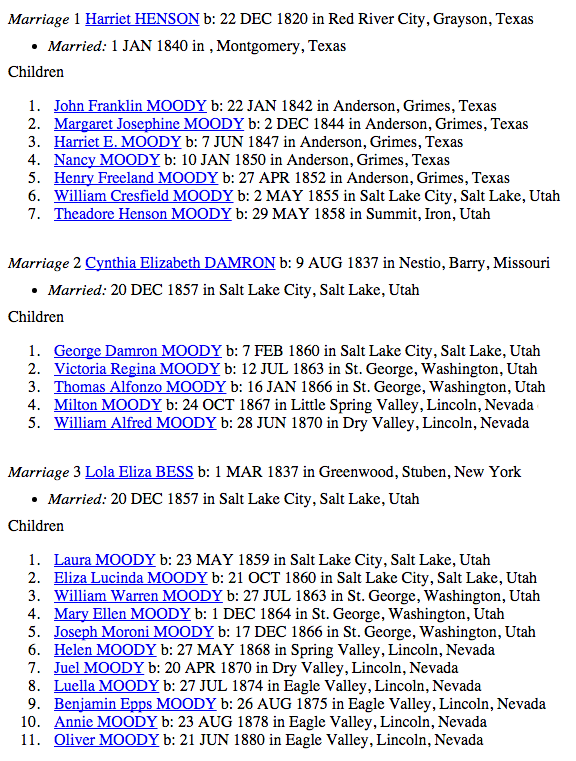
The photo below shows Lola Eliza Bess, William Cresfield Moody, and some of their children:
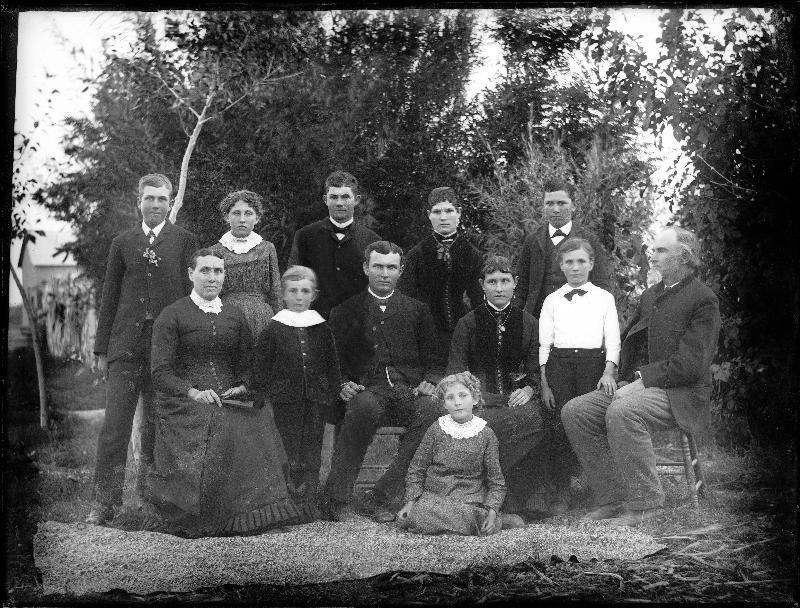
Pictured above, Back Row Left to Right: Juel (1870), Luella (1874), Milton (1867), Helen (1868),
William Alfred (1870). Front Row: Lola Eliza Bess (1837), Oliver (1879), Joseph Moroni (1866),
Annie Moody (1878), Eliza Lucinda (1860), Benjamin Epps (1875), William C. Moody (1819).
* Milton (1867) and William Alfred (1870) are the sons of Cynthia Elizabeth Damron
* * * * * * *
King Charlemagne is My 29th Great Grandfather
and You're Likely Related to Him, Too!
by Matt Moody, Ph.D.
While on a trip to New York, I saw the Broadway play "Pippin." It's a story about how the son of King Charlemagne, Prince Pippin, is trying to find the meaning of life -- to find his "Corner of the Sky" as the song goes. He tries to find life's meaning through money, fame, pleasure, and power, but none of these pursuits bring him happiness. He finally discovers joy in a love relationship with a single mother.
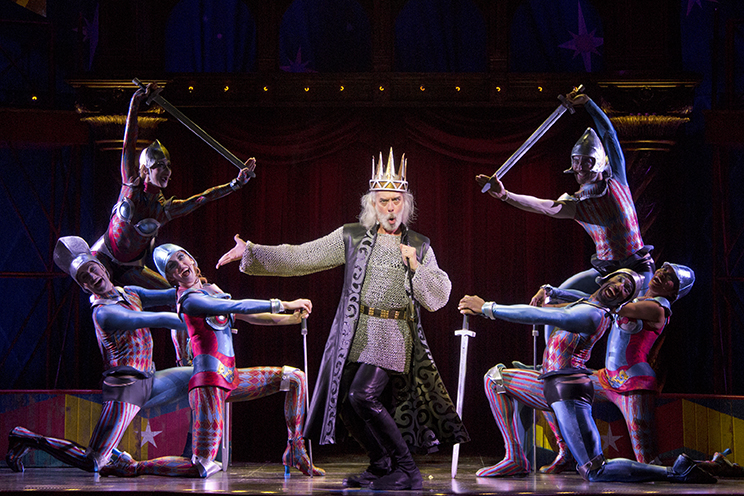

Ever since I saw this Broadway play, I've been fascinated with King Charlemagne and Prince Pippin. Recently, I started climbing my Family Tree at FamilySearch.org and just kept climbing through family lines that kept going back and back -- 1600's and then the 1300's and the 900's and I finally found Prince Pippin (785 A.D.) and King Charlemagne (742 A.D.), both born in France.
I found this connection through a random Tree Climbing, and I've since discovered that, beginning from 5 of my 8 great grandparents, I can trace each family line to Prince Pippin and his father King Charlemagne: Emperor of the Holy Roman Empire. Truth is, most everyone who has ancestors in Great Britain will likely find ancestors across the English Channel into France, and end up being related to Pippin and Charlemagne! Let me explain why.
One reason that all genealogical roads lead to King Charlemagne is because the further you go back in time, it is the "royal lines" that survive -- because the "royals" had the money and means to make sure genealogical records were written and safely stored for posterity. And there is yet another reason why you and I and almost everyone else is related to King Charlemagne: in fact, there are a 100 million reasons!
If you were born about 1966, then your parents, on average, would be born about 1933, and your grandparents 1900. So every hundred years, there are at least 3 generations in an individual's Family ancestry. Now, it's possible that there could be 4 generations in a hundred years period -- when a person's ancestral line passes through children born at the top of the birth order, and when parents married early, around age 20.
For example: You is you were born about 1975, your parent were born about 1950, your grandparents were born about 1925, and finally your great grandparents were born about 1900. But some parents marry later than age 20, and some children are born deeper into the birth order, 10 or more years after a couple has been married. For example, my mother gave birth to me when she was 44 years old.
So the following shows the number of great grandparents you will have in each generation, and also estimates the number of generations per century of time:
You 1
Parents 2
Grandparents 4 born in the 1900's
Great-Grandparents 8
2nd Great-Grandparents 16
3rd Great-Grandparents 32 born in the 1800's
4th Great-Grandparents 64
5th Great-Grandparents 128
6th Great-Grandparents 256 born in the 1700's
7th Great-Grandparents 512
8th Great-Grandparents 1,024
9th Great-Grandparents 2,048 born in the 1600's
10th Great-Grandparents 4,096
11th Great-Grandparents 8,192
12th Great-Grandparents 16,384 born in the 1500's
13th Great-Grandparents 32,768
14th Great-Grandparents 65,536
15th Great-Grandparents 131,072 born in the 1400's
16th Great-Grandparents 262,144
17th Great-Grandparents 524,288
18th Great-Grandparents 1,048,576 born in the 1300's
19th Great-Grandparents 2,097,152
20th Great-Grandparents 4,194,304
21st Great-Grandparents 8,388,608 born in the 1200's
22nd Great-Grandparents 16,777,216
23rd Great-Grandparents 33,554,432
24th Great-Grandparents 67,108,864 born in the 1100's
25th Great-Grandparents 134,217,728
* 26th Great-Grandparents 268,415,456
27th Great-Grandparents 536,830,912 born in the 1000's
28th Great-Grandparents 1,073,662,834
29th Great-Grandparents 2,147,325,668
30th Great-Grandparents 4,294,651,336 born in the 900's
31st Great-Grandparents 8,589,302,672
32nd Great-Grandparents 17,178,605,344
33rd Great-Grandparents 34,357,210,688 born in the 800's
* The earth's population in 1000 AD was about 250,000,000 -- so the mathematical doubling of great grandparents in earlier generations hits a bottle neck at a certain point. This means that further mathematical doubling doesn't really occur because the "doubling totals" are MORE than the population of the earth at a particular time in history.
Even though one person could theoretically have 1 Million 18th great grandparents from the early 1300's, the number of contributing great-great grandparents is actually less, because 3rd or 4th or 5th (etc.) cousins end up marrying due to geographic proximity constraints; meaning, people have a limited number marital-partner choices within a geographical region. Thus patterns of propinquity create many duplications of great-great (etc.) grandparents in a person's family tree.
For example, here's a Relationship Path Chart that shows how my youngest son Devin is an 11th cousin to his soon-to-be wife:

If we just kept doubling the number of grandparents every generation, by the early 800's the number of 33rd great grandparents, for one person living in 2015, would be about 34 billion -- but that's impossible, because the population of the earth in the 800's was about 200 million. And the population of the earth in 2025 is just 8.25 Billion.
Again, this means that the ancestral doubling, from one generation to the next, hits a bottle-neck at the year 1000 A.D., where a person would theoretically have 250 million 26th great grandparents, AND the population of the earth is about 250 million.
So as you climb higher and higher up a Family Tree, your ancestry will naturally begin to narrow, because the SAME 20th great grandparents can appear at the top of your Family Tree multiple times. Further, we know that the ancestral line MUST NECESSARILY NARROW at the top of the Family Tree. Why? Because the Human Family began with just 2 people, Adam and Eve!
So, the reason why most Caucasians in North America and Europe will have Family Lines that pass through Prince Pippin and King Charlemagne of France, is because there are 100's of Millions of contributing great grandparents in every person's Family Tree at the 29th generation.
* * * * * * *
Counseling Approach: Adapting Language to Each Client
Teaching People How To Do Family History Research Online
Determined and Dependable: Dr Matt's Family Heritage
Premise for Family History Therapy: Why It Works
Who was Marilyn Monroe's Biological Father?
Excerpts from Changing Your Stripes
Tell-Tale Signs of Betrayal
* * * * * * *
Other Articles of Interest: New Age Philosophy: Wolf in Sheep's Clothing
Doing Genealogy at FamilySearch.org
Principles of Emotional Healing
* * * * * * *
The Greatest Prize
for Life's labors isn't
in material possessions
or impressive accomplishments,
but in the progress of personal character.
You labor for your own becoming, this is your richest reward.
Who You Become is your greatest possession,
make it your Masterpiece!
~ Changing Your Stripes, 2nd Edition, p. 274
The book, "Changing Your Stripes" presents principles for getting out of
the ditch in which you've been dumped (the difficulties of which you are a victim), and
the ditch in which you've jumped (the difficulties for which you volunteer).
"Mastering a challenging situation
is ultimately a matter of
mastering yourself!"
~ Matt Moody
"Changing Your Stripes," teaches you the principles that lead to lasting change,
making you a new kind of creature capable of communicating
with calm, even as storms of contention swirl.
If these principles resonate and ring true,
then . . . this book is for you!

Sold Exclusively
through this website
Changing Your Stripes is a
unique reference book that will help
you understand, . . . and solve all of
Life's ever-appearing problems.
Here are more reasons to buy
Changing Your Stripes

Social Psychologist & Personal Advisor

